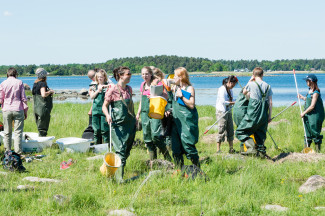
Johns Hopkins UniversityEst. 1876
America’s First Research University
Essential Readings in Wildlife Management

Wildlife management and conservation is a relatively new field of study, having its origins in 1933 when Aldo Leopold, the Father of Wildlife Management, published his landmark text, Game Management. The data and information he used were primarily from state and federal reports, or his own data or observations, as there were no peer-reviewed journals in existence at that time on the subject that he could examine and cite.
The Wildlife Society was founded, in great part to the efforts of Aldo Leopold, in 1937, and the Journal of Wildlife Management was first published in the same year. The first article was titled, “The Evaluation of Nesting Losses and Juvenile Mortality of the Ring-Necked Pheasant” by Paul L. Errington and F. N. Hamerstrom, Jr. The Society of American Foresters was formed in 1900 by Gifford Pinchot and the Journal of Forestry was first published in 1917. Other key peer-reviewed journals relevant to wildlife ecology included Ecology (established 1919), Journal of Ecology (1913), Journal of Animal Ecology (1932), Journal of Applied Ecology (1964), Journal of Range Management (1948), and Canadian Journal of Zoology (1951). Since these times, thousands of research articles have been published regarding wildlife ecology and management and consequently, the field of study of wildlife management moved from being an “Art” to a “Science”.
But during these 80 plus years, there arose a suite of publications that would be cited again and again. These would form the foundational literature of the wildlife management field of study. They are cited repeatedly in the scientific literature and in the textbooks used in undergraduate and graduate classrooms. Two examples include C.S. Elton’s paper titled, “Periodic fluctuations in the numbers of animals: their causes and effects” which has been cited 706 times, and A.J. Nicholson’s paper titled, “The balance of animal populations” cited 1,179 times. Every field of study-- forestry, ecology, conservation biology, range management, and others- has these core, foundational papers. But, they are scattered throughout volumes and volumes within libraries, or within gigabytes of electronically stored copies. Being foundational in nature, the practicing wildlife biologist or academician would find themselves referring back to these papers to re-read or distribute to students or colleagues.

Aside from the work involved in such exercises, there was the issue of copyright, which often hindered the widespread copying and distribution of these papers. Lastly, even with electronic access, students who were surveyed indicated in a strong majority (>66%) the desire to have hard copies of key textbooks. Consequently, we teamed up with an Editor of Johns Hopkins University Press and The Wildlife Society to assemble those peer-reviewed papers that were foundational to the field of wildlife management and conservation. As a start, we surveyed wildlife biologists throughout the world regarding what papers they thought were foundational. It was surprising as we saw that the suggested papers were quite consistent!
A core list of papers formed and the list did not differ greatly from our initial list of papers. Regardless. we had more papers we thought were foundational than could “fit” in a textbook that was cost-effective. After numerous iterations, we finally reduced our list to those articles found in our textbook today, partitioned into 4 topical areas: Our Philosophical Roots, Animals, Ecology & Populations, Habitat, and Human Dimensions. In another 5 years, we will have to expand this textbook as the wildlife field of study continues to expand, adding additional key topical areas, thus the foundational literature will very likely include more than 4 topical areas.
Paul R. Krausman is emeritus professor at the University of Arizona and a past president of The Wildlife Society. He is the co-editor of Wildlife Management and Conservation: Contemporary Principles and Practices. Wildlife biologist Bruce D. Leopold is retired. He was formerly a professor in the Department of Wildlife, Fisheries, and Aquaculture at Mississippi State University, the executive director of the Center for Resolving Human-Wildlife Conflicts, and a past president of The Wildlife Society.


